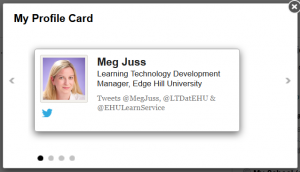
-
Introduction to Profiles and Social Learning Tools in Blackboard
 Blackboard’s ‘Social Learning Tools’ form a small scale social networking style environment within Blackboard, which your students can use outside of their course areas. They include the Profile tool, People tool, Messages tool, and Spaces tool.
Blackboard’s ‘Social Learning Tools’ form a small scale social networking style environment within Blackboard, which your students can use outside of their course areas. They include the Profile tool, People tool, Messages tool, and Spaces tool.The Profile tool will be the one you are most likely to have noticed. The profile pictures feed into Blackboard’s discussion tool, making it easier to see who posted what. The pictures are also used throughout the Social Learning Tools, which you can access through the Global Navigation link at the top right of the Blackboard environment, which has your name on it.
We have written a staff focused overview guide about the Social Learning Tools and a more in depth one about the Spaces tool.
The Social Learning Tools were improved as part of the Blackboard Community upgrade to our system, and a recent update adds important features. The update ensures that students have agreed to Blackboard’s terms of service before they use the tools, and they will be reminded of the section of Edge Hill University’s IT Acceptable Use Policy that relates to social networking type activity. Also, they will have more control over your own information as they will be able to delete their profiles while they are a student with access to Blackboard. Inactive account holders will be notified after 12 months that their profile will be deleted, so even if they don’t get round to deleting their profile it won’t be there forever.
-
Abandon survey fatigue and tell us what you think!
Learning Services have run an annual student e-learning survey since 2008. This year we thought we’d do something different and focus on the academic staff experience instead.
You may have seen slides on the plasma screens or received a flyer exhorting staff to take part in the Learning Services survey … and to date 70 of you have very kindly done so. We want to hear about your experiences of Edge Hill’s virtual and physical teaching environments, Library and resources. We also want to get a better understanding of how you like to keep up-to-date with our new developments and how you engage with Learning Services learning technologists, librarians and classroom support staff.
We know it’s a big ask but can you take 5-10 minutes and fill the survey in? You can access it from http://surveys.edgehill.ac.uk/staff_survey
Your responses will be used to improve what we do, for example, we have used the feedback from the annual student e-learning survey to inform major Learning Edge developments including Mobile Learn, the recent addition of Community, 1-Click access from Go, and our Get Connected student Roadshows. We have also used your feedback from the 2012 Audio Visual Technology survey to identify and upgrade classrooms in need of new AV.
Lindsey Martin
Assistant Head of Learning Services (Learning, ICT & Media Technologies)
-
Alas Prescott and Ellis
… it’s a bit like having a tutorial with you …
An initial request to create an online session for the PG Cert in HE has resulted in a wealth of video resources ranging from academic writing to change management and leadership that are now used across a number of programmes in the Faculty of Health and Social Care. Trish Prescott and Jeannette Ellis, both Senior Lecturers in the Faculty, produced these resources using an approach that role models a ‘conversation’ . This blog post reflects that conversational approach, with input from Trish (T:) and Jeannette (J:):
 T: We were asked to do a session on Critical Reflection for the PG Cert – a course for staff that are new to teaching in Higher Education. We wanted to try something different – to expose new teachers to a different style of teaching and learning. So we created a screencast [a PowerPoint presentation narrated by Trish and Jeannette] supported by a World Café approach in the follow up face to face.
T: We were asked to do a session on Critical Reflection for the PG Cert – a course for staff that are new to teaching in Higher Education. We wanted to try something different – to expose new teachers to a different style of teaching and learning. So we created a screencast [a PowerPoint presentation narrated by Trish and Jeannette] supported by a World Café approach in the follow up face to face.J: We wanted to get peers/colleagues to engage online before the face to face session – so in class we could do exercises and build on material they had already engaged with.
T: We had some issues with the technology and the process …
J: … our first attempt didn’t record anything! But now we can initiate it all with occasional help – and have even done some fading in and out!
T: Beyond the PG Cert we’ve had a series of evaluations from a blended undergraduate CPD programme asking for more face to face sessions …
J: …so we created screencasts that were perhaps more engaging than some of the existing online activities. Initial topics included:
– Academic writing and referencing
– Doing critical reflection …T: … and then more sessions for the undergraduate dissertation.
Q: Can you tell me more about your approach?
J: We put ourselves in the students’ shoes – Trish is the ‘academic’ and I am the potentially knowledgeable but not expert student. So I pose questions that I feel a student would ask when they are in a room with you. So you are creating a situation that is almost mimicking what students want to ask but often don’t feel that they can or that they want to.
T: Just putting up a PowerPoint is a one direction approach. Having a conversation allows a debate, and the feedback that we’ve had so far is that ‘it feels like we’re having a 1-2-1 tutorial with you because of the engagement that is going on’ … and that’s why I think it works really well with two of us rather than just one of us talking over it.
J: We’ve created screencasts covering topics such as academic writing and referencing, practice innovation, change management, and leadership. Feedback from the Advancing Practice module was “ … really good, it strengthens the delivery.”
Q: How are you sharing with colleagues?
T: We’ve put generic resources on Blackboard and would encourage other tutors to direct their groups to these resources to ‘deliver’, and then follow with a workshop / Q&A session – this would be a more efficient use of time.
J: Chris Jones and I presented at the staff study day – our session was called “Facing students in alternative ways”. The idea was to share ways of offering a voice of the tutor in formats other than face to face
T: For the PG Cert course it was about role modelling different ways of doing things so that tutors can see ideas in practice and make it theirs.
Q: What feedback have you had?
J: The most significant comment for me was from one of Trish’s students:
“ … it’s a bit like having a tutorial with you … “
… because it almost is:
- it’s orientated to the individual
- they pace it and place it according to their own need;
- it’s dead easy to start, stop or skip.
Q: What are your next steps in the project?
J: So far we’ve limited our opportunities to voice – just talking over a PowerPoint. We are aware that Camtasia would afford us an opportunity to have ‘talking head’ video of us on screen – that’s probably the next level.
T: We’re looking at other software that will allow us to develop a really interactive online session – with lots of activities, things to read, interactive quizzes etc.
J: As well as improving the process of creating screencasts, we’ve also got much better at the content. For instance, Trish now gives a breakdown at the start of each screencast – saying how long it will take. If that’s a long time I’ll suggest they think about breaks; it’s perfectly OK to walk away from it – when they come back they can scroll to where they left off.
Q: What issues and concerns have there been?
T: We thought we’d need a script – but that didn’t work out well.
J: If you’re reading from a script it’s awful – it doesn’t work. It’s got to be natural, in ‘real time’, saying what you are thinking. So what we do now is to have a conversation before we record – perhaps making a few notes on the slides about what we really want to cover – and then just let it go!
T: Students like the result – and we don’t bother editing our mistakes / giggles out – the students have said that these are ‘ … really nice.’.
Q: Where do you record your screencasts – do you book a room?
J: Yes and no. At the moment we are using the old TV studio in LINC – right next door to the Learning Technology team where we pick the laptop up from.
T: This is a really good example of the ‘New Academic Team’ – because it was technologists and us working together to enhance the student experience. Everyone in the LTD team has been very supportive – helping us whenever we turn up.
Q: Did the project meet your expectation?
J: I think, it surpassed it in many ways … we didn’t have any expectations
T: We would try this and see what happens.
J: The driver was to make it better for the student. There was an expectation to improve things, so from that perspective it has, although we haven’t done any formal evaluation.
Q: What system do you put the screencasts on?
J: We use YouTube – we send them to the Media team in Learning Services who put them on the FoHSC’s YouTube channel – and we link to there from Blackboard – it’s very easy.
Q: What is your advice to other looking at doing this?
J: ’Give it a go’.
T: Microphones – get a proper desk microphone …
J: … don’t do what we did and twist a headset microphone – making it look like a pretzel! You need a USB mic.
T: Get help from the Learning Technology team. We still go back to LTD for the final steps of the screencasting process – the ‘publishing’.
J: Take a ‘bite sized’ approach – limit screencasts to 40 minutes or so – and build in activities too.
Jeannette Ellis
Senior Lecturer
Faculty of Health & Social CareTrish Prescott
Senior Lecturer in CPD, Learning and Teaching Fellow
Faculty of Health & Social CareThe approach that Trish and Jeannette are taking is the Flipped Model – something that is very current in the TEL field – being cited by the Horizon Report of 2014 as an ‘Important Development in Educational Technology’ that is ‘One Year or Less’ from mainstream adoption: (http://www.nmc.org/publications/2014-horizon-report-higher-ed)
 A great ‘getting started’ guide for Camtasia written by Peter Beaumont of LTD is available on eShare: http://www.eshare.edgehill.ac.uk/3912/
A great ‘getting started’ guide for Camtasia written by Peter Beaumont of LTD is available on eShare: http://www.eshare.edgehill.ac.uk/3912/For further help, support and advice on how you can use Camtasia and similar tools to create video ‘content’ for your students please contact your Learning Technologist (see the Faculty Contacts on this page) or email the LTD Team on [email protected] or 01695 650754 (x7754).



